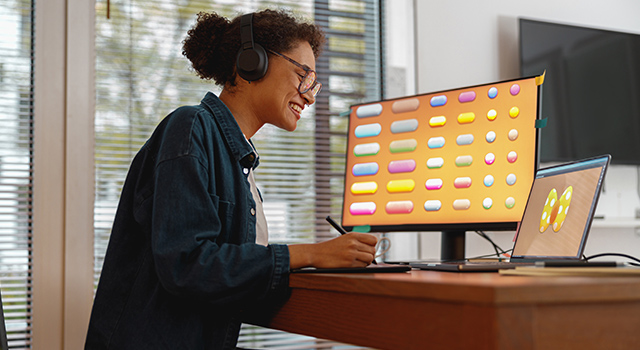“Any tool can be used for good or bad. It’s really the ethics of the artist using it.” So says John Knoll, the groundbreaking Visual Effects Supervisor and Chief Creative Officer at Industrial Light and Magic, and the visual creative force behind Star Wars, Star Trek, and Pirates of the Caribbean.
This sentiment is more relevant than ever in today’s current politically and socially charged climate. Discourse over the ethical application of technology, art, expression, and policy in the wake of global environmental and ecological dissension is a hot topic in 2018.
As the conduits of visual communication for brand awareness, marketing, advertising, and media in a consumer-focused culture, designers are at a crossroads between ethics and convenience, where one must bridge business objectives with a moral and ethical compass.
Ethical Design must broaden its scope to incorporate the motif of political and social commentary about eco-sustainability, environmental, gender, and racial inclusivity, and humane approaches to consumerism.
The role of the designer is now a movement that has the power to redirect the conversation of Ethical Design to a more expansive level of social consciousness.
What position does the UX designer assume in this context? And how does the designer resolve the potential moral, psychological, and environmental consequences of Ethical Design about the impact on brands, technology, and process?
Unethical vs. Ethical Design
Designers are problem solvers and vessels of antistatic articulation. As influencers of public view, they’re situated in a powerful position. Logos, illustration, topography, digital media, and production layouts are created to entice, inform, inspire, and motivate the consumer.
There are some Unethical Design principles that take advantage of the human condition, and is something that designers should be aware of and avoid:
- Surveillance Capitalism: Data-driven design that’s used for financial gain or intent, such as using data to profile people to substantial adverse effect, minimizing their choices and opportunities.
- Dark Patterns: Design that’s used to trick consumers into action or behavior in a way that someone might not necessarily want to act. It’s applied to take advantage of weaknesses in the human brain. It’s commonly seen in aggressive loss aversion advertising techniques.
The responsibility of the designer to shift creativity and UX in a meaningful direction is a valuable narrative, now more than ever. The growing sense of urgency to contribute a diversified perspective on Ethical Design is providing a framework for research, application, and reciprocity-design cycle for designers.
It’s difficult, if not impossible, in some circumstances to act autonomously when creating to represent a specific message or brand image. The designer is left in an ethical gray area where loss of livelihood and career can become the consequence of a decision to choose an ethical “high ground.”
However, there are creative and technological innovations, educational outlets, and guidelines that support an altruistic approach to design and the UX.
The Bonding of Technology and Sustainable Design
Digital Ethics Labs are gaining attention in such venerable institutions as Oxford, which launched a Digital Ethics Lab that addresses ethical challenges presented by digital innovation.
The motivation is to find benefits and promote positive opportunities for developing technology, science, law, business, politics, and social issues. In a digital context, with the escalating effect of disruptive transformation, ethical consequences are serious and directly impact humanity.
Oxford’s lab director, Luciano Floridi, states “ethical mistakes are increasingly costly and viable…we believe technology can and must help environmental problems…”
Designers have to evolve to provide device independent services that promote technology in “service of the people its intended to serve.” Dialogues and interactive panels at notable festivals such as SXSW are bringing to light the role of the designer in a technologically dependent world, and posing questions about the trust placed in designers to create for the complete human experience.
The Designer’s Oath is an explorative study of Ethical Design and an evolving tool for a code of ethics that guides processes to a result that is inherently good. It invites designers to contribute to a discussion on how to collectively and individually problem solve and design in the spirit of community, sustainability, and social impact.
Ethical Doctrines of Methodology and Technology
The Institute of Electrical and Electronics Engineers (IEEE) released a report discussing the philosophical and social intersection of technology and ethics and how to successfully navigate it as a designer, guided by five principles:
- Prioritizing and Utilizing established metrics for calculating wellbeing.
- Protecting Human rights.
- Ensuring Designers and operators of digital technologies are held accountable for their creations.
- Embracing transparent processes.
- Reducing the risk of misuse.
Designers need to take ownership and responsibility for broader social concerns and learn effective ways to address them through problem-solving and artistic interpretation to ensure that results genuinely benefit culture, humankind, and our planet.
Designers are not adrift in a sea of ethical and moral design ambiguity. There are guiding doctrines available which are backed by a study, evidence, and research.
An ethical hierarchy of design is configured to revolve around:
- Human Rights: Promotes and protects basic civil liberties, emphasizing democracy, and minimizing inequality by utilizing technology that is peer focused, decentralized, end-to-end encrypted, accessible, and sustainable.
- Human Effort: Mindful of the time humans exist on the planet and embracing those that are differently enabled by employing technology that’s respectful of human effort in a serviceable and opportune way.
- Human Experience: Being empowered by positivity and finding joy by using technology in an attractive and pleasing way.
The pyramid-shaped design of this hierarchy has interesting implications, for if one of these layers is compromised, the entire ethical structure collapses. It’s incumbent on the designer to select and apply technology as thoughtfully and ethically as the conception of the design itself.
In this vein, the Human-Centered Design (HCD), developed by the UX Professionals Association, offers studies that support active user involvement, and design culture of empathy in design experience methodology.
Low-Impact Practices and Artistic Sustainability
2018 stands to be a year of transition and radical change in creative design. Designers can use their position to spark awareness, attention, and concern regarding Ethical Design, and ensure that consumers are impacted, informed, and enticed by meaningful, eco-sustainable, and sociologically significant design.
As designers invested in positive global change, Artwork Adobe (AWA) is committed to minimizing our ecological footprint through thoughtful utilization of design and technology. Serving companies and individuals in ways that lift the human experience while still creating to meet distinctive business vision are the beating heart of AWA’s creative compass.
– Artwork Abode




